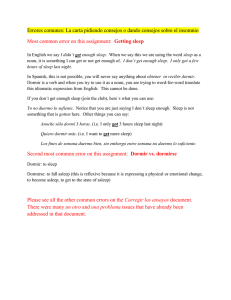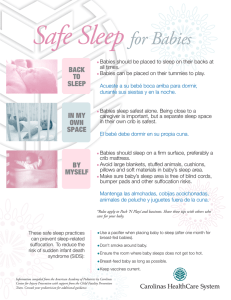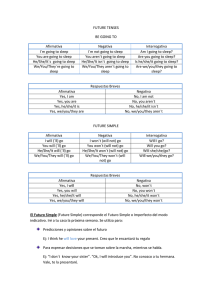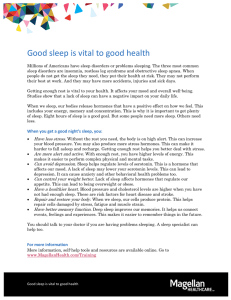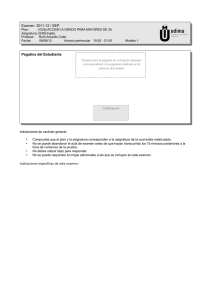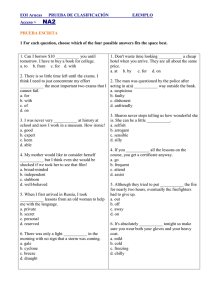Efsa Scientific Opinion on the substantiation of health claims related to melatonin and alleviation of subjective feelings of jet lag (ID 1953), and reduction of sleep onset latency, and improvement of sleep quality (ID 1953) pursuant to Article 13(1) of Regulation (EC) No 1924/20061
Anuncio
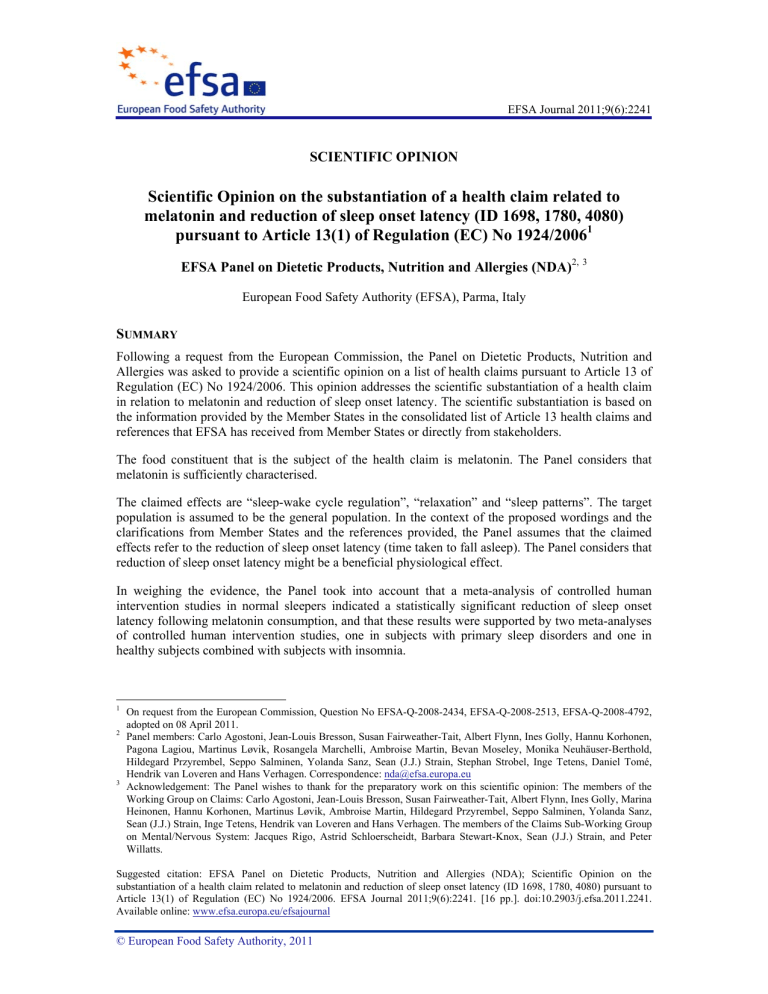
EFSA Journal 2011;9(6):2241 SCIENTIFIC OPINION Scientific Opinion on the substantiation of a health claim related to melatonin and reduction of sleep onset latency (ID 1698, 1780, 4080) pursuant to Article 13(1) of Regulation (EC) No 1924/20061 EFSA Panel on Dietetic Products, Nutrition and Allergies (NDA)2, 3 European Food Safety Authority (EFSA), Parma, Italy SUMMARY Following a request from the European Commission, the Panel on Dietetic Products, Nutrition and Allergies was asked to provide a scientific opinion on a list of health claims pursuant to Article 13 of Regulation (EC) No 1924/2006. This opinion addresses the scientific substantiation of a health claim in relation to melatonin and reduction of sleep onset latency. The scientific substantiation is based on the information provided by the Member States in the consolidated list of Article 13 health claims and references that EFSA has received from Member States or directly from stakeholders. The food constituent that is the subject of the health claim is melatonin. The Panel considers that melatonin is sufficiently characterised. The claimed effects are “sleep-wake cycle regulation”, “relaxation” and “sleep patterns”. The target population is assumed to be the general population. In the context of the proposed wordings and the clarifications from Member States and the references provided, the Panel assumes that the claimed effects refer to the reduction of sleep onset latency (time taken to fall asleep). The Panel considers that reduction of sleep onset latency might be a beneficial physiological effect. In weighing the evidence, the Panel took into account that a meta-analysis of controlled human intervention studies in normal sleepers indicated a statistically significant reduction of sleep onset latency following melatonin consumption, and that these results were supported by two meta-analyses of controlled human intervention studies, one in subjects with primary sleep disorders and one in healthy subjects combined with subjects with insomnia. 1 2 3 On request from the European Commission, Question No EFSA-Q-2008-2434, EFSA-Q-2008-2513, EFSA-Q-2008-4792, adopted on 08 April 2011. Panel members: Carlo Agostoni, Jean-Louis Bresson, Susan Fairweather-Tait, Albert Flynn, Ines Golly, Hannu Korhonen, Pagona Lagiou, Martinus Løvik, Rosangela Marchelli, Ambroise Martin, Bevan Moseley, Monika Neuhäuser-Berthold, Hildegard Przyrembel, Seppo Salminen, Yolanda Sanz, Sean (J.J.) Strain, Stephan Strobel, Inge Tetens, Daniel Tomé, Hendrik van Loveren and Hans Verhagen. Correspondence: [email protected] Acknowledgement: The Panel wishes to thank for the preparatory work on this scientific opinion: The members of the Working Group on Claims: Carlo Agostoni, Jean-Louis Bresson, Susan Fairweather-Tait, Albert Flynn, Ines Golly, Marina Heinonen, Hannu Korhonen, Martinus Løvik, Ambroise Martin, Hildegard Przyrembel, Seppo Salminen, Yolanda Sanz, Sean (J.J.) Strain, Inge Tetens, Hendrik van Loveren and Hans Verhagen. The members of the Claims Sub-Working Group on Mental/Nervous System: Jacques Rigo, Astrid Schloerscheidt, Barbara Stewart-Knox, Sean (J.J.) Strain, and Peter Willatts. Suggested citation: EFSA Panel on Dietetic Products, Nutrition and Allergies (NDA); Scientific Opinion on the substantiation of a health claim related to melatonin and reduction of sleep onset latency (ID 1698, 1780, 4080) pursuant to Article 13(1) of Regulation (EC) No 1924/2006. EFSA Journal 2011;9(6):2241. [16 pp.]. doi:10.2903/j.efsa.2011.2241. Available online: www.efsa.europa.eu/efsajournal © European Food Safety Authority, 2011 Melatonin and reduction of sleep onset latency On the basis of the data presented, the Panel concludes that a cause and effect relationship has been established between the consumption of melatonin and reduction of sleep onset latency. The Panel considers that in order to obtain the claimed effect, 1 mg of melatonin should be consumed close to bedtime. The target population is the general population. KEY WORDS Melatonin, sleep onset latency, insomnia, health claims. EFSA Journal 2011;9(6):2241 2 Melatonin and reduction of sleep onset latency TABLE OF CONTENTS Summary .................................................................................................................................................. 1 Table of contents ...................................................................................................................................... 3 Background as provided by the European Commission........................................................................... 4 Terms of reference as provided by the European Commission ................................................................ 4 EFSA Disclaimer ...................................................................................................................................... 4 Information as provided in the consolidated list ...................................................................................... 5 Assessment ............................................................................................................................................... 5 1. Characterisation of the food/constituent (ID 1698, 1780, 4080) ..................................................... 5 2. Relevance of the claimed effect to human health (ID 1698, 1780, 4080) ....................................... 5 3. Substantiation of the claimed effect (ID 1698, 1780, 4080) ............................................................ 5 4. Panel’s comments on the proposed wording (ID 1698, 1780, 4080) .............................................. 7 5. Conditions and possible restrictions of use (ID 1698, 1780, 4080)................................................. 8 Conclusions .............................................................................................................................................. 8 Documentation provided to EFSA ........................................................................................................... 8 References ................................................................................................................................................ 8 Appendices ............................................................................................................................................. 10 Glossary and Abbreviations ................................................................................................................... 16 EFSA Journal 2011;9(6):2241 3 Melatonin and reduction of sleep onset latency BACKGROUND AS PROVIDED BY THE EUROPEAN COMMISSION See Appendix A TERMS OF REFERENCE AS PROVIDED BY THE EUROPEAN COMMISSION See Appendix A EFSA DISCLAIMER See Appendix B EFSA Journal 2011;9(6):2241 4 Melatonin and reduction of sleep onset latency INFORMATION AS PROVIDED IN THE CONSOLIDATED LIST The consolidated list of health claims pursuant to Article 13 of Regulation (EC) No 1924/20064 submitted by Member States contains main entry claims with corresponding conditions of use and literature for similar health claims. EFSA has screened all health claims contained in the original consolidated list of Article 13 health claims which was received by EFSA in 2008 using six criteria established by the NDA Panel to identify claims for which EFSA considered sufficient information had been provided for evaluation and those for which more information or clarification was needed before evaluation could be carried out5. The clarifications which were received by EFSA through the screening process have been included in the consolidated list. This additional information will serve as clarification to the originally provided information. The information provided in the consolidated list for the health claims which are the subject of this opinion is tabulated in Appendix C. ASSESSMENT 1. Characterisation of the food/constituent (ID 1698, 1780, 4080) The food constituent that is the subject of the health claim is melatonin. Melatonin is a hormone produced by the pineal gland during the hours of darkness. Melatonin can be measured by established methods. The Panel considers that the food constituent, melatonin, which is the subject of the health claim, is sufficiently characterised. 2. Relevance of the claimed effect to human health (ID 1698, 1780, 4080) The claimed effects are “sleep-wake cycle regulation”, “relaxation” and “sleep patterns”. The Panel assumes that the target population is the general population. In the context of the proposed wordings and the clarifications provided from Member States and the references provided, the Panel assumes that the claimed effects refer to the reduction of sleep onset latency (time taken to fall asleep). Sleep onset latency can be measured by validated methods. The Panel concludes that reduction of sleep onset latency might be a beneficial physiological effect. 3. Substantiation of the claimed effect (ID 1698, 1780, 4080) A claim on melatonin and reduction of sleep onset latency and improvement of sleep quality has already been assessed with an unfavourable outcome (EFSA Panel on Dietetic Products Nutrition and Allergies (NDA), 2010), based on a meta-analysis (Buscemi et al., 2006) of randomised controlled trials (9 studies) conducted in subjects with sleep disorders under sleep restrictions (subjects with changes in sleep pattern, e.g. after jet lag, shift work or induced insomnia), which did not show an effect of melatonin consumption on sleep onset latency or sleep quality. The references provided for the scientific substantiation of the present claim included textbooks, an extract from the proceeding of a colloquium, and narrative reviews, which did not provide any original data for the scientific substantiation of the claim. An abstract and a reference were also submitted in 4 5 Regulation (EC) No 1924/2006 of the European Parliament and of the Council of 20 December 2006 on nutrition and health claims made on foods. OJ L 404, 30.12.2006, p. 9–25. EFSA Panel on Dietetic Products, Nutrition and Allergies (NDA), 2011. General guidance for stakeholders on the evaluation of Article 13.1, 13.5 and 14 health claims. EFSA Journal, 9(4):2135, 24 pp. EFSA Journal 2011;9(6):2241 5 Melatonin and reduction of sleep onset latency which the information provided regarding the study design, methodology and statistical analyses was insufficient for a full scientific evaluation. Some of the references were on substances other than melatonin (lutein and zeaxanthin), on intranasal administration of melatonin, which is not a route considered relevant for human nutrition, or dealt with outcomes, such as subjective feeling of jet lag or subjective sleepiness (without any specific measurements related to sleep onset latency), chemistry of ligands at the membrane receptors of melatonin, melatonin delivery in pharmacological formulations, the secretion of melatonin, and modification of the biological rhythms of core body temperature, cortisol and melatonin secretion in response to nocturnal bright light stimuli in combination with melatonin supplementation, which were unrelated to the claimed effect. Two references reported on the effects of melatonin either in healthy subjects after an overnight sleep deprivation (Tzischinsky and Lavie, 1994) (sleep restriction has already been evaluated in the previous opinion on melatonin), or in subjects with secondary sleep disorders (women with mild or moderate asthma) (Campos et al., 2004). The Panel considers that no conclusions can be drawn from these references for the scientific substantiation of the claim. Three meta-analyses of controlled trials, which assessed the effect of melatonin consumption on sleep onset latency in healthy subjects without insomnia (Buscemi et al., 2004), in subjects with primary sleep disorders (Buscemi et al., 2005), or in healthy subjects with or without insomnia (Brzezinski et al., 2005), were not considered in the aforementioned published opinion (EFSA Panel on Dietetic Products Nutrition and Allergies (NDA), 2010), and included all the individual human intervention studies provided for the scientific substantiation of the present claim. The meta-analysis by Buscemi et al. (2004) considered controlled trials (published between 1966 and 2003) which had investigated the effect of melatonin administration on objective sleep outcome measures, including sleep onset latency, in adult normal sleepers. Sleep outcomes were measured by polysomnography, actigraphy or questionnaires. Twenty studies which compared the effect of melatonin (n=225 subjects) vs. placebo (n=206 subjects) met the inclusion criteria. Eighteen studies had a cross-over design. Study duration ranged from one night to five weeks. The doses of melatonin administered ranged from 0.1 to 100 mg, and were categorised according to the following levels: <1 mg; 1-3 mg; 4-5 mg; 6-10 mg; >10 mg. The meta-analysis was performed using a random effects model, and fixed effects were considered in a sensitivity analysis. Study quality was low-to-moderate (i.e. none of the studies reported a power calculation for the primary outcome, and although all studies involved a placebo control, many did not apply random allocation to the intervention group). The meta-analysis showed a statistically significant decrease in sleep onset latency following melatonin administration compared to placebo (combined weighted mean difference (WMD): -3.9 min; 95% CI -5.3, -2.6). The sub-group analysis regarding the dosage of melatonin showed a statistically significant decrease in sleep onset latency after melatonin administration compared to placebo for all considered dosage ranges (<1 mg, five studies; 1-3 mg, 10 studies; 4-5 mg, six studies; 6-10 mg, seven studies) except for the highest doses (>10 mg, two studies). The meta-analysis by Buscemi et al. (2005) considered controlled studies (published between 1966 and 2004) which had investigated the effect of melatonin administration on objective sleep outcome measures, including sleep onset latency, in subjects with sleep disorders (insomnia, delayed sleep-phase syndrome). Sleep outcomes were measured by polysomnography, actigraphy or questionnaires. Fourteen studies, which compared the effect of melatonin administered before bedtime (n=218 subjects) vs. placebo (n=207 subjects), met the inclusion criteria. Eleven studies had a cross-over design. The studies were conducted in children (2 studies), adults aged 19-65 (7 studies), and adults aged 66 years and older (5 studies). The meta-analysis was performed using a random effects model, owing to the high heterogeneity observed in the study results. Study quality was ranked as moderate to high by the authors. The meta-analysis showed a statistically significant decrease in sleep onset latency after melatonin administration compared to placebo (WMD: -11.7 min; 95 % CI -18.2, -5.2). The sub-group analysis regarding the dosage of melatonin showed a statistically significant decrease in sleep onset latency after melatonin administration compared to placebo for the dosage ranges 1-3 mg (six studies), but not for <1 mg (two studies) or for 4-5 mg (seven studies). EFSA Journal 2011;9(6):2241 6 Melatonin and reduction of sleep onset latency The Panel notes that, in the two meta-analyses (Buscemi et al., 2004; Buscemi et al., 2005), the lower end of the dose ranges of the sub-group analyses for which a significant effect of melatonin on sleep onset latency was consistently found is 1 mg. The meta-analysis by Brzezinski et al. (2005) included double-blind randomised controlled trials (published between 1980 and 2003) which investigated the effect of melatonin consumption on objective sleep outcome measures. Sleep outcomes were measured by polysomnography, actigraphy or the index finger switch depression method. Twelve of the 17 studies included in the meta-analysis provided measures of sleep onset latency. Six studies were conducted on healthy volunteers, four on subjects with insomnia, one on both healthy volunteers and insomniacs, and one on a combination of institutionalised and free-living subjects with insomnia. Sample size ranged from 6 to 30 subjects, all studies had a cross-over design with or without a wash-out phase, duration ranged from one night to three weeks, melatonin doses from 0.1 to 40 mg/day, and either one or multiple melatonin doses were tested in the same study. Considering these 12 studies (n=172 subjects), melatonin significantly reduced sleep onset latency by 3.9 min (95 % CI -2.5, -5.4) compared to placebo. Removing the two smallest studies (6 and 8 subjects, respectively) from the analysis, because of the presence of outliers in the data set or heterogeneity of the data, led to a reduction of sleep onset latency of 7.4 min (95 % CI -5.1, -9.8) in favour of melatonin. The Panel considers that the results of this meta-analysis can be used as evidence for the substantiation of the claim, but notes some methodological limitations, including the lack of extensive sensitivity analysis or adjustment for the different doses used in the various studies. The Panel notes that the major difference between the four meta-analyses (Brzezinski et al., 2005; Buscemi et al., 2004; Buscemi et al., 2005; Buscemi et al., 2006) was the population groups considered. The Buscemi et al. (2006) analysis considered in the previously published opinion (EFSA Panel on Dietetic Products Nutrition and Allergies (NDA), 2010) did not show a significant effect of melatonin consumption on sleep onset latency in a sub-group analysis considering subjects with sleep restrictions (after jet lag, shift work or induced insomnia). In contrast, the analysis by Buscemi et al. (2004) in normal sleepers, together with the sub-analysis by Brzezinski et al. (2005) in healthy subjects or subjects with no relevant medical condition other than insomnia (excluding studies on sleep restriction), and the analysis by Buscemi et al. (2005) in subjects with primary sleep disorders (insomnia, delayed sleep-phase syndrome) found statistically significant effects of melatonin consumption on sleep onset latency. Overall, the Panel notes that the three meta-analyses considered in this opinion showed a significant effect of melatonin on sleep onset latency. In the two meta-analyses (Buscemi et al., 2004; Buscemi et al., 2005), the lower end of the dose ranges of the sub-group analyses for which a significant effect of melatonin on sleep onset latency was consistently found is 1 mg. In weighing the evidence, the Panel took into account that a meta-analysis of controlled human intervention studies in normal sleepers indicated a statistically significant reduction of sleep onset latency following melatonin consumption, and that these results were supported by two meta-analyses of controlled human intervention studies, one in subjects with primary sleep disorders and one in healthy subjects combined with subjects with insomnia. The Panel concludes that a cause and effect relationship has been established between the consumption of melatonin and reduction of sleep onset latency. 4. Panel’s comments on the proposed wording (ID 1698, 1780, 4080) The Panel considers that the following wording reflects the scientific evidence: “Melatonin helps to reduce the time to fall asleep”. EFSA Journal 2011;9(6):2241 7 Melatonin and reduction of sleep onset latency 5. Conditions and possible restrictions of use (ID 1698, 1780, 4080) The Panel considers that in order to obtain the claimed effect, 1 mg of melatonin should be consumed close to bedtime. The target population is the general population. CONCLUSIONS On the basis of the data presented, the Panel concludes that: • The food constituent, melatonin, which is the subject of the health claim, is sufficiently characterised. • The claimed effects are “sleep-wake cycle regulation”, “relaxation” and “sleep patterns”. The target population is assumed to be the general population. Reduction of sleep onset latency might be a beneficial physiological effect. • A cause and effect relationship has been established between the consumption of melatonin and reduction of sleep onset latency. • The following wording reflects the scientific evidence: “Melatonin helps to reduce the time to fall asleep”. • In order to obtain the claimed effect, 1 mg of melatonin should be consumed close to bedtime. The target population is the general population. DOCUMENTATION PROVIDED TO EFSA Health claims pursuant to Article 13 of Regulation (EC) No 1924/2006 (No: EFSA-Q-2008-2434, EFSA-Q-2008-2513, EFSA-Q-2008-4792). The scientific substantiation is based on the information provided by the Member States in the consolidated list of Article 13 health claims and references that EFSA has received from Member States or directly from stakeholders. The full list of supporting references as provided http://www.efsa.europa.eu/panels/nda/claims/article13.htm. to EFSA is available on: REFERENCES Brzezinski A, Vangel MG, Wurtman RJ, Norrie G, Zhdanova I, Ben-Shushan A and Ford I, 2005. Effects of exogenous melatonin on sleep: a meta-analysis. Sleep Medicine Reviews, 9, 41-50. Buscemi N, Vandermeer B, Pandya R, Hooton N, Tjosvold L, Hartling L, Baker G, Vohra S and Klassen T, 2004. Melatonin for Treatment of Sleep Disorders. Summary, Evidence Report/Technology Assessment No. 108. (Prepared by the University of Alberta Evidence-based Practice Center, under Contract No. 290-02-0023) AHRQ Publication No. 05-E002-1. Agency for Healthcare Research and Quality, Rockville. Buscemi N, Vandermeer B, Hooton N, Pandya R, Tjosvold L, Hartling L, Baker B, Klassen T and Vohra S, 2005. The efficacy and safety of exogenous melatonin for primary sleep disorders: a meta-analysis. Journal of General Internal Medicine, 20, 1151–1158. Buscemi N, Vandermeer B, Hooton N, Pandya R, Tjosvold L, Hartling L, Vohra S, Klassen T and Baker G, 2006. Efficacy and safety of exogenous melatonin for secondary sleep disorders and sleep disorders accompanying sleep restriction: meta-analysis. British Medical Journal (Clinical Research Edition), 332, 385-393. EFSA Journal 2011;9(6):2241 8 Melatonin and reduction of sleep onset latency Campos FL, da Silva-Junior FP, de Bruin VM and de Bruin PF, 2004. Melatonin improves sleep in asthma: a randomized, double-blind, placebo-controlled study. American Journal of Respiratory and Critical Care Medicine, 170, 947-951. EFSA Panel on Dietetic Products Nutrition and Allergies (NDA), 2010. Scientific Opinion on the substantiation of health claims related to melatonin and alleviation of subjective feelings of jet lag (ID 1953), and reduction of sleep onset latency, and improvement of sleep quality (ID 1953) pursuant to Article 13(1) of Regulation (EC) No 1924/2006. EFSA Journal 2010; 8(2):1467, 18 pp. Tzischinsky O and Lavie P, 1994. Melatonin possesses time-dependent hypnotic effects. Sleep, 17, 638-645. EFSA Journal 2011;9(6):2241 9 Melatonin and reduction of sleep onset latency APPENDICES APPENDIX A BACKGROUND AND TERMS OF REFERENCE AS PROVIDED BY THE EUROPEAN COMMISSION The Regulation 1924/2006 on nutrition and health claims made on foods6 (hereinafter "the Regulation") entered into force on 19th January 2007. Article 13 of the Regulation foresees that the Commission shall adopt a Community list of permitted health claims other than those referring to the reduction of disease risk and to children's development and health. This Community list shall be adopted through the Regulatory Committee procedure and following consultation of the European Food Safety Authority (EFSA). Health claims are defined as "any claim that states, suggests or implies that a relationship exists between a food category, a food or one of its constituents and health". In accordance with Article 13 (1) health claims other than those referring to the reduction of disease risk and to children's development and health are health claims describing or referring to: a) the role of a nutrient or other substance in growth, development and the functions of the body; or b) psychological and behavioural functions; or c) without prejudice to Directive 96/8/EC, slimming or weight-control or a reduction in the sense of hunger or an increase in the sense of satiety or to the reduction of the available energy from the diet. To be included in the Community list of permitted health claims, the claims shall be: (i) based on generally accepted scientific evidence; and (ii) well understood by the average consumer. Member States provided the Commission with lists of claims as referred to in Article 13 (1) by 31 January 2008 accompanied by the conditions applying to them and by references to the relevant scientific justification. These lists have been consolidated into the list which forms the basis for the EFSA consultation in accordance with Article 13 (3). ISSUES THAT NEED TO BE CONSIDERED IMPORTANCE AND PERTINENCE OF THE FOOD7 Foods are commonly involved in many different functions8 of the body, and for one single food many health claims may therefore be scientifically true. Therefore, the relative importance of food e.g. nutrients in relation to other nutrients for the expressed beneficial effect should be considered: for functions affected by a large number of dietary factors it should be considered whether a reference to a single food is scientifically pertinent. 6 OJ L12, 18/01/2007 The term 'food' when used in this Terms of Reference refers to a food constituent, the food or the food category. 8 The term 'function' when used in this Terms of Reference refers to health claims in Article 13(1)(a), (b) and (c). 7 EFSA Journal 2011;9(6):2241 10 Melatonin and reduction of sleep onset latency It should also be considered if the information on the characteristics of the food contains aspects pertinent to the beneficial effect. SUBSTANTIATION OF CLAIMS BY GENERALLY ACCEPTABLE SCIENTIFIC EVIDENCE Scientific substantiation is the main aspect to be taken into account to authorise health claims. Claims should be scientifically substantiated by taking into account the totality of the available scientific data, and by weighing the evidence, and shall demonstrate the extent to which: (a) the claimed effect of the food is beneficial for human health, (b) a cause and effect relationship is established between consumption of the food and the claimed effect in humans (such as: the strength, consistency, specificity, doseresponse, and biological plausibility of the relationship), (c) the quantity of the food and pattern of consumption required to obtain the claimed effect could reasonably be achieved as part of a balanced diet, (d) the specific study group(s) in which the evidence was obtained is representative of the target population for which the claim is intended. EFSA has mentioned in its scientific and technical guidance for the preparation and presentation of the application for authorisation of health claims consistent criteria for the potential sources of scientific data. Such sources may not be available for all health claims. Nevertheless it will be relevant and important that EFSA comments on the availability and quality of such data in order to allow the regulator to judge and make a risk management decision about the acceptability of health claims included in the submitted list. The scientific evidence about the role of a food on a nutritional or physiological function is not enough to justify the claim. The beneficial effect of the dietary intake has also to be demonstrated. Moreover, the beneficial effect should be significant i.e. satisfactorily demonstrate to beneficially affect identified functions in the body in a way which is relevant to health. Although an appreciation of the beneficial effect in relation to the nutritional status of the European population may be of interest, the presence or absence of the actual need for a nutrient or other substance with nutritional or physiological effect for that population should not, however, condition such considerations. Different types of effects can be claimed. Claims referring to the maintenance of a function may be distinct from claims referring to the improvement of a function. EFSA may wish to comment whether such different claims comply with the criteria laid down in the Regulation. WORDING OF HEALTH CLAIMS Scientific substantiation of health claims is the main aspect on which EFSA's opinion is requested. However, the wording of health claims should also be commented by EFSA in its opinion. There is potentially a plethora of expressions that may be used to convey the relationship between the food and the function. This may be due to commercial practices, consumer perception and linguistic or cultural differences across the EU. Nevertheless, the wording used to make health claims should be truthful, clear, reliable and useful to the consumer in choosing a healthy diet. In addition to fulfilling the general principles and conditions of the Regulation laid down in Article 3 and 5, Article 13(1)(a) stipulates that health claims shall describe or refer to "the role of a nutrient or other substance in growth, development and the functions of the body". Therefore, the requirement to EFSA Journal 2011;9(6):2241 11 Melatonin and reduction of sleep onset latency describe or refer to the 'role' of a nutrient or substance in growth, development and the functions of the body should be carefully considered. The specificity of the wording is very important. Health claims such as "Substance X supports the function of the joints" may not sufficiently do so, whereas a claim such as "Substance X helps maintain the flexibility of the joints" would. In the first example of a claim it is unclear which of the various functions of the joints is described or referred to contrary to the latter example which specifies this by using the word "flexibility". The clarity of the wording is very important. The guiding principle should be that the description or reference to the role of the nutrient or other substance shall be clear and unambiguous and therefore be specified to the extent possible i.e. descriptive words/ terms which can have multiple meanings should be avoided. To this end, wordings like "strengthens your natural defences" or "contain antioxidants" should be considered as well as "may" or "might" as opposed to words like "contributes", "aids" or "helps". In addition, for functions affected by a large number of dietary factors it should be considered whether wordings such as "indispensable", "necessary", "essential" and "important" reflects the strength of the scientific evidence. Similar alternative wordings as mentioned above are used for claims relating to different relationships between the various foods and health. It is not the intention of the regulator to adopt a detailed and rigid list of claims where all possible wordings for the different claims are approved. Therefore, it is not required that EFSA comments on each individual wording for each claim unless the wording is strictly pertinent to a specific claim. It would be appreciated though that EFSA may consider and comment generally on such elements relating to wording to ensure the compliance with the criteria laid down in the Regulation. In doing so the explanation provided for in recital 16 of the Regulation on the notion of the average consumer should be recalled. In addition, such assessment should take into account the particular perspective and/or knowledge in the target group of the claim, if such is indicated or implied. TERMS OF REFERENCE HEALTH CLAIMS OTHER THAN THOSE REFERRING TO THE REDUCTION OF DISEASE RISK AND TO CHILDREN'S DEVELOPMENT AND HEALTH EFSA should in particular consider, and provide advice on the following aspects: ¾ Whether adequate information is provided on the characteristics of the food pertinent to the beneficial effect. ¾ Whether the beneficial effect of the food on the function is substantiated by generally accepted scientific evidence by taking into account the totality of the available scientific data, and by weighing the evidence. In this context EFSA is invited to comment on the nature and quality of the totality of the evidence provided according to consistent criteria. ¾ The specific importance of the food for the claimed effect. For functions affected by a large number of dietary factors whether a reference to a single food is scientifically pertinent. In addition, EFSA should consider the claimed effect on the function, and provide advice on the extent to which: ¾ the claimed effect of the food in the identified function is beneficial. EFSA Journal 2011;9(6):2241 12 Melatonin and reduction of sleep onset latency ¾ a cause and effect relationship has been established between consumption of the food and the claimed effect in humans and whether the magnitude of the effect is related to the quantity consumed. ¾ where appropriate, the effect on the function is significant in relation to the quantity of the food proposed to be consumed and if this quantity could reasonably be consumed as part of a balanced diet. ¾ the specific study group(s) in which the evidence was obtained is representative of the target population for which the claim is intended. ¾ the wordings used to express the claimed effect reflect the scientific evidence and complies with the criteria laid down in the Regulation. When considering these elements EFSA should also provide advice, when appropriate: ¾ on the appropriate application of Article 10 (2) (c) and (d) in the Regulation, which provides for additional labelling requirements addressed to persons who should avoid using the food; and/or warnings for products that are likely to present a health risk if consumed to excess. EFSA Journal 2011;9(6):2241 13 Melatonin and reduction of sleep onset latency APPENDIX B EFSA DISCLAIMER The present opinion does not constitute, and cannot be construed as, an authorisation to the marketing of the food/food constituent, a positive assessment of its safety, nor a decision on whether the food/food constituent is, or is not, classified as foodstuffs. It should be noted that such an assessment is not foreseen in the framework of Regulation (EC) No 1924/2006. It should also be highlighted that the scope, the proposed wordings of the claims and the conditions of use as proposed in the Consolidated List may be subject to changes, pending the outcome of the authorisation procedure foreseen in Article 13(3) of Regulation (EC) No 1924/2006. EFSA Journal 2011;9(6):2241 14 Melatonin and reduction of sleep onset latency APPENDIX C Table 1. Main entry health claims related to melatonin, including conditions of use from similar claims, as proposed in the Consolidated List. ID 1698 Food or Food constituent Melatonine Health Relationship Ritmo sonno-veglia Clarification provided Sleep-wake cycle regulation Proposed wording Favorisce i ritmi fisiologici come il ciclo sonno-veglia; Regolarizza il ritmo del sonno. Clarification provided Helps to regulate circadian rhythm. Improves sleep-wake cycle. Helps to regulate sleep rhythm. Conditions of use ID 1780 max 5 mg/die Food or Food constituent Melatonin Health Relationship Relaxation Proposed wording Promotes normal sleep Conditions of use - 2 mg No clarification provided by Member States ID Food or Food constituent 4080 Melatonin (including from plant sources e.g. Graminaceae, such as Festuca arundinacea) Health Relationship Sleep patterns Clarification provided Proposed wording Melatonin may help to promote restful sleep/normal sleep patterns. Sleep-wake cycle regulation. Supports the onset of sleep. Conditions of use - Adult dosage: 50 mcg – 10 mg melatonin daily. Naturally-occurring (botanically sourced) melatonin may be effective at considerably lower dosages (microgram rather than milligram quantities) than synthetic melatonin, hence the wide dosage range. Most trials have been conducted on = 0.1 mg dosages. EFSA Journal 2011;9(6):2241 15 Melatonin and reduction of sleep onset latency GLOSSARY AND ABBREVIATIONS CI Confidence interval WMD Weighted mean difference EFSA Journal 2011;9(6):2241 16

